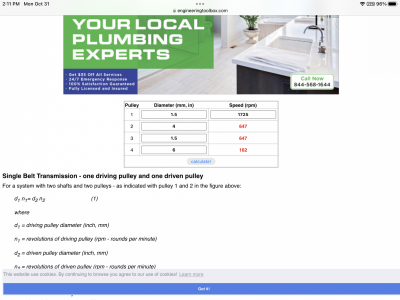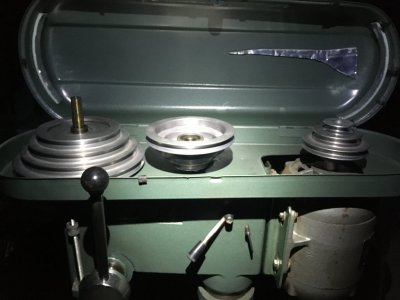-
Welcome back Guest! Did you know you can mentor other members here at H-M? If not, please check out our Relaunch of Hobby Machinist Mentoring Program!
You are using an out of date browser. It may not display this or other websites correctly.
You should upgrade or use an alternative browser.
You should upgrade or use an alternative browser.
Slowing Drill Press RPM's
- Thread starter slowneasy
- Start date
- Joined
- Jan 25, 2015
- Messages
- 2,558
Well, that sure looks like it could have been the "King Canada" era.View attachment 425225
This is just "mocked" up, the pulley on the motor is just sitting on the shaft, not all the way down
But it's definitely a rebranded import (King Canada doesn't manufacture any tools itself)...likely from Taiwan.
- Joined
- Aug 22, 2012
- Messages
- 4,121
stuck a treadmill motor with speed controller on mine.
Ok so very slow speeds have limited torque but it does everything I want it to.
I use 2" -3" dia hole saws at very slow speed on aluminium and steel, sometimes they grab a stall but generally keep going with enough lube.
Ok so very slow speeds have limited torque but it does everything I want it to.
I use 2" -3" dia hole saws at very slow speed on aluminium and steel, sometimes they grab a stall but generally keep going with enough lube.
- Joined
- Mar 25, 2013
- Messages
- 4,617
I highly recommend a sewing machine motor:

 www.hobby-machinist.com
www.hobby-machinist.com
This guy has an eBay store. Search for "The Custom Crafter". He has several motor sizes available.

Clausing Drill Press (new to me)
I just got this sewing machine motor in the mail today: In spite of its small size it is rated at 1HP and goes up to 4000 RPM. I plan to replace the drill press motor with this and have the added advantage of full speed control. I hope the torque will be adequate. I plan to use the pulleys to...
 www.hobby-machinist.com
www.hobby-machinist.com
This guy has an eBay store. Search for "The Custom Crafter". He has several motor sizes available.
- Joined
- Feb 13, 2017
- Messages
- 2,138
A much better representation of the problem. It looks very much like my Craftsman 17" machine from ~25 years ago. First off, I will withdraw my ramblings from last night. You have basicly two options for using the existing belts: First is a DC motor and controller. The other is to use the gear reduction I posted earlier. I don't like VFDs, they don't work all that well at low speeds. They are good drives, but not as much as they are touted. I used them in industrial applications, they may do better in small shops.
There are some calculations you can do that will get you close for speeds. You state the motor is 1800 RPM. I take that to mean it is less "slip" which will place it at 1740ish. Basicly a 4 pole induction motor. The pulley ratios are measured by the "pitch diameters", roughly half way from the OD and the ID. Calculating from OD will get you coursely near. Figure each belt position, I would bet the lowest speed is around 200 RPM. Up or down a little, but close to it.
A "sewing machine" motor would be a good choice. In the size needed it will basicly be an AC/DC notor. Like a treadmill motor but "stouter". They are "series universal" motors and will run on AC or DC, simply by varying voltage. Most associations to a sewing machine are for the smaller home machines. A commercial machine has a motor the size of an entire home machine. Be sure the controller comes with it. A small treadle can't handle the current involved.
Purely my perspective here: Going much slower will be in the range of a milling machine. That's what I bought the HF MiniMill for. But I do small work, you would want something a little bigger. At very slow speeds and high torque there may be belt slippage. That's where the final reduction gear set comes into play. A DP has quill bearings that do well for direct pressure but are weak for side play. If you are ever tempted to do side cutting, remember that! A drill press is not a milling machine.
.
There are some calculations you can do that will get you close for speeds. You state the motor is 1800 RPM. I take that to mean it is less "slip" which will place it at 1740ish. Basicly a 4 pole induction motor. The pulley ratios are measured by the "pitch diameters", roughly half way from the OD and the ID. Calculating from OD will get you coursely near. Figure each belt position, I would bet the lowest speed is around 200 RPM. Up or down a little, but close to it.
A "sewing machine" motor would be a good choice. In the size needed it will basicly be an AC/DC notor. Like a treadmill motor but "stouter". They are "series universal" motors and will run on AC or DC, simply by varying voltage. Most associations to a sewing machine are for the smaller home machines. A commercial machine has a motor the size of an entire home machine. Be sure the controller comes with it. A small treadle can't handle the current involved.
Purely my perspective here: Going much slower will be in the range of a milling machine. That's what I bought the HF MiniMill for. But I do small work, you would want something a little bigger. At very slow speeds and high torque there may be belt slippage. That's where the final reduction gear set comes into play. A DP has quill bearings that do well for direct pressure but are weak for side play. If you are ever tempted to do side cutting, remember that! A drill press is not a milling machine.
.
Last edited:
I’m visually estimating 20:1 reduction in those pulleys. You should be able to get RPMs below a hundred with that. Even if it’s only 10:1, it’s below 200 RPMs. How slow is your target?
It takes a powerful and strong drill press to drill a 1” hole in steel.
Rick “4:1 motor to jackshaft and 5:1 to jackshaft to spindle” Denney
It takes a powerful and strong drill press to drill a 1” hole in steel.
Rick “4:1 motor to jackshaft and 5:1 to jackshaft to spindle” Denney
Yes, I would also estimate the current lowest RPM to be around 225-240. I would like to see at least 150 RPM at the lowest setting. 100 RPM would be icing on the cake. I'm not sure what I could see if I only changed the intermediate step pulley. I will look into that but not expecting to get what I'd like to see
I would definitely like to put 1" holes in steel but I always start with smaller drills first. Not just starting with a 1" drill. I do have a handful of 3MT/2MT drills as well that would be nice to use them as well.
I would definitely like to put 1" holes in steel but I always start with smaller drills first. Not just starting with a 1" drill. I do have a handful of 3MT/2MT drills as well that would be nice to use them as well.
- Joined
- Sep 5, 2013
- Messages
- 3,207
It’s pretty simple to do the math but you will need to measure some sheaves first, otherwise it will stay at guesswork. There are also a number of on-line calculators available that take all the effort out of the calculations, just input the numbers. This one is from Engineering Toolbox. I’ve just plugged in what look like may be close to the sheave sizes based on the photo.


- Joined
- Jan 25, 2015
- Messages
- 2,558
Calculator I often use:
 www.blocklayer.com
www.blocklayer.com
Pulleys and Belts - Inch
Visually calculate pulley size rpm belt length and speed wwith animated scaled diagrams - Inch


